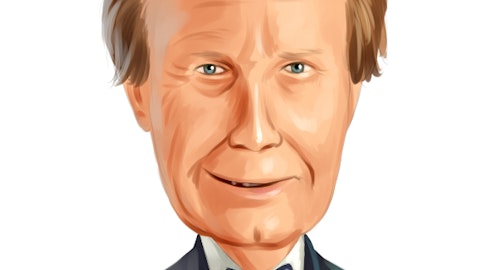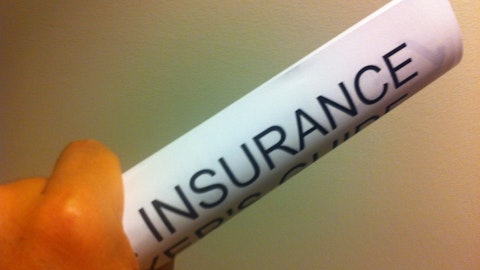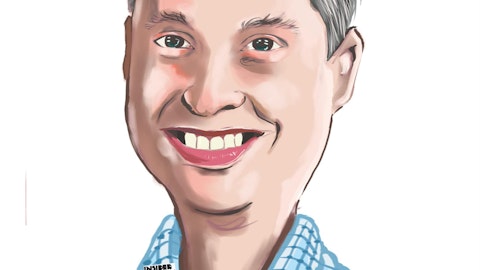Kingstone Companies, Inc. (NASDAQ:KINS) Q3 2022 Earnings Call Transcript November 15, 2022
Kingstone Companies, Inc. misses on earnings expectations. Reported EPS is $-0.35 EPS, expectations were $-0.02.
Operator: Greetings, and welcome to Kingstone Companies, Inc. Third Quarter 2022 Earnings Call. As a reminder, this conference is being recorded. It is now my pleasure to introduce your host, Rich Swartz, Chief Accounting Officer. Thank you, sir. You may begin.
Rich Swartz: Thank you very much, Maria, and good morning, everyone. Yesterday afternoon, the company issued a press release detailing Kingstone’s 2022 third quarter results. On this call, Kingstone may make forward-looking statements regarding itself and its business. The forward-looking events and circumstances discussed on this call may not occur and could differ materially as a result of known and unknown risk factors and uncertainties affecting Kingstone. For more information, please refer to the section entitled Factors That May Affect Future Results and Financial Condition in Part 1, Item 1A of the company’s Form 10-K for the year ended December 31, 2021, along with commentary on forward-looking statements at the end of the company’s earnings release issued yesterday.
In addition, our remarks today include references to non-GAAP measures. For a reconciliation of our non-GAAP measures to the GAAP figures, please see the tables in our earnings release. With that, I’d like to turn the call over to Kingstone’s CEO, Mr. Barry Goldstein. Please go ahead, Mr. Goldstein.

Adam Gregor/Shutterstock.com
Barry Goldstein: Thanks, Rich, and good morning, everyone, and thank you for joining us on our third quarter 2022 conference call. Before we get into a discussion on our financial and operational results, I want to provide you an update on a few matters that I know are top of mind for you all. First, as we’ve said, our Board and management team regularly review Kingstone’s strategic, operational and financial priorities with the objective of driving stockholder value. As it relates to our ongoing discussions with Griffin Highline specifically, as you’ll recall, in August, Griffin Highline submitted a final nonbinding indication of interest to the Board, proposing to acquire all of the outstanding equity of the company. We agreed to extend the period of exclusivity with Griffin Highline to further pursue that proposal, and that period of exclusivity has since expired.
At this time, our discussions are focused on a potential strategic transaction with them rather than an outright acquisition of Kingstone. While no assurances can be given that a transaction of any kind will be consummated with Griffin Highline or any third party, our Board is committed to acting in the best interest of the company and our stockholders. We will continue to take actions consistent with that objective. Our goal remains to be as transparent as possible, and I’m personally committed to providing updates as appropriate. That said, I am limited in this regard given the confidentiality agreement in place and must stay within the bounds of what we’re legally able to say. Today, as in our prior calls, we will only accept questions from the analysts that cover the stock.
Second, as the Board considers all value-creating opportunities, as a management team, we are not sitting still. We’ve made significant progress executing on our operational plan, which I’ll touch on in a moment. This transformation to a stronger Kingstone has continued in the midst of a challenging inflationary environment, one which is heightened for companies like ours, which are highly regulated. As you know, Kingstone sets its premium rates annually in advance. And when we took our rate of rate – our round of rate changes in the summer and fall of 2021, inflation was in the 4% range. Today, significant uncertainty remains despite the more favorable inflation data released at the end of last week, which showed the annual inflation rate for the U.S. at 7.7% for the 12 months ended October 2022.
The reality of our business is such that we cannot adjust our prices like most others in real time in order to flow through to the consumer the higher loss cost we incur. We recognize this is putting pressure on our stock price, but I want you to know that I’m confident in our foundation and believe that the changes we have invested in will put us back on the path to profitability. As you know, this return to profitability has been the single biggest focus of our Kingstone 2.0 plan. I am pleased to report that 2.0 is now complete. It’s taken us almost three years of hard work and significant capital investment to provide a product to better select our risks, to better underwrite and price our risks, and better manage them on a single efficient platform.
While it’s still in its early days, we are already seeing positive results. We began writing our new Select product in New York, our home state and a state that accounts for about 80% of our total premium. Let me share some very exciting details. Total new business premium is up about 9%, driven by an increase in average new business premium per policy of 8%, that is it’s 8% higher than the average premium than we generated in 2021 from the legacy product. As a reminder, average premium being up has very little to do with the sale of more policies. What’s important is that we’re able to charge a higher price for the policies we are selling. That’s one part of the story, higher average premiums on new business. But another important piece is our better matching of rate to risk, most importantly, how Select new business claims frequency is almost 20% lower than what we experienced the new business in our legacy product for the same period last year.
Combining higher premiums with reduced risk is translating into wider margins and higher underwriting profits. We’re delighted with the enhanced risk selection tools built into Select, reflecting the elevated quality of our new policyholders as most qualify for our lowest-priced tiers even with our stringent underwriting standards. In short, since completing Kingstone 2.0, we are already reporting higher average premiums, lower claims frequency and a far better mix of business. These are all great signs for the future. And while our work is never done, what we have seen is better than what we had anticipated, and we could not be more optimistic about Select. Recall that premiums are earned over the life of a policy, so the expected benefits of higher earned premium and lower loss cost will be earned in over time.
Beyond our home state of New York, we continue to take rate in all states to account for the trends in our business, including inflation, which I said has an outside impact on us as a regulated company. We are adding to premium not only through rate filings, which are averaging 9%, but by annual adjustments to coverage to properly reflect a home’s increased replacement cost, again, driven by inflation. All new homes underwritten by Kingstone are insured to 100% of their replacement cost, and all renewing policies are updated to reflect the then current replacement costs. The combination of these actions, which vary by state, will be very material. Importantly, we continue to manage our portfolio to grow only in states and segments where we are earning an acceptable return.
We are re-underwriting our entire book, taking actions subject to regulatory constraints to increase our returns and eliminate the underperformers. As we’ve worked towards completing Kingstone 2.0, we remain focused on operating with financial discipline and look to reduce our expenses across the business. As a result, expenses were down 2.4 points for the quarter and almost 4 points on a year-to-date basis. We are pleased to see these cost-cutting measures take hold, and we are actively working to drive further expense reduction, including through the retirement of our legacy systems. We’ve also taken important steps towards refinancing certain senior unsecured notes that will become due on December 30, 2022. We explored a number of financing and other options that were available to us.
We are working diligently with our bankers and attorneys on a solution that, if finalized as I hope, will result in a reduction to our outstanding indebtedness by utilizing the liquidity now on hand at our holding company. Note that subject to regulatory requirements, Kingstone can also receive dividends or loans from our insurance subsidiary, Kingstone Insurance Company, that could be used to repay a portion of the notes. In light of the upcoming refinancing and our desire to maintain financial flexibility, we announced yesterday that Kingstone Board is determined to suspend the company’s quarterly dividend effective immediately. We believe this is the prudent decision at this time in order to preserve capital to potentially help fund this refinancing and the resulting debt service requirements, as any refinancing will result in borrowing costs at a higher interest rate than for those of the maturing notes.
And we anticipate cash savings of $1.7 million annually as a result of the dividend suspension. The Board will continue to evaluate the company’s dividend policy on a regular basis, including based on any contractual restrictions imposed in connection with any debt refinancing. In summary, we are continuing to work diligently to fully realize the benefits of our transformation. While our net earnings and book value declined primarily due to the continuing impacts of inflation, our adjusted book value per share for the quarter was $5.15. As a reminder, this is a non-GAAP measure and excludes the impact that interest rate changes have had on our fixed income portfolio. As I turn the page – all right, I am all out of order here. Before I turn the call over to Meryl, I want to reiterate three things: one, our Board is open to all options to enhance stockholder value; two, we are not sitting still and are taking every action to best position Kingstone for the future, including with respect to the upcoming refinancing; and three, we are optimistic that the changes we have invested in through our recently completed Kingstone 2.0 will result in our return to profitability.
I’m going to turn the call over to Meryl to continue. Meryl, please go ahead.
See also 10 Biggest Energy Drink Companies in the World and 13 Best Undervalued Stocks To Buy.
Meryl Golden: Thanks, Barry. The company posted a third quarter net loss of $4 million or $0.38 per diluted share compared to a net loss of $10.6 million or $1.01 per diluted share for the same period last year. Note that the mark-to-market decline in our equity portfolio amounted to $0.13 a share. Direct written premium for the quarter were up $5.7 million from the prior year to $54.6 million. Almost all this growth was due to rate increases. During the third quarter, our written premium increased by 11.7%, while our policies in force grew only 0.2%. We remain focused on increasing our average premium and expect to continue to grow premiums materially faster than exposures for the foreseeable future. The net loss and LAE ratio was 75%, down 22.1 points from the prior year when we experienced a large number of catastrophe claims.
This quarter, the impact of catastrophes was de minimis, adding just over 1 point to loss ratio compared to 33 points from the prior year. The attritional or non-cat loss ratio was higher than the prior year and attributable to two main items. First, the largest driver was an increase in severity for non-weather water losses, reflecting the impact of inflation. Please be aware that the frequency of water losses was in line with the prior year quarter, but severity was materially elevated as remediation and repair costs reflect not only inflation in materials, but the increase in non-skilled labor wage rates. Second, we experienced an increase in frequency for our livery physical damage product. However, this line of business continues to be quite profitable.
We are working hard to keep pace with and hopefully stay ahead of inflation, though it continues to weigh on our financial results. Inflation in loss cost requires us to increase premium rates in all states, and these rate increases have averaged about 9%. Barry talked about making sure that newly covered homes are insured to their current replacement costs. We are also updating replacement costs on all of our policies at renewal. These coverage increases could result in an additional 8% to 10% of premium, depending on retention. We recognize that the combination of higher rates and higher insert values could contribute to a significant decline in retention. But thus far, that is not the case. We attribute this both to customer stickiness and to market conditions as other insurers make similar changes to address inflation as well.
These efforts will be increasingly reflected in our results as the higher premiums earn in over time. For the current quarter, the net underwriting expense ratio decreased 2.4 points to 36.9%. Our expense reduction is driven by the quota share and corresponding ceding commission, but also by multiple expense reduction initiatives from Kingstone 2.0 that are starting to take hold. Note that the significant capital expenditures that were required to design, build and roll out Select and allow us to get off our legacy systems will no longer burden our future, and capital expenditures going forward will be greatly reduced. We’ve made great progress on expenses, but are engaged in other efforts which will reduce expenses even further. As Barry mentioned, we have completed our Kingstone 2.0 initiative and have taken numerous actions to address inflation, but it takes time to see these benefits reflected in our financial results.
I want to thank the entire Kingstone team for their incredibly hard work. We are continuing to work diligently to return the company to profitability and are evaluating all options available to us to ensure the company is best positioned to get there. With that, operator, please open the line for questions.
Q&A Session
Follow Kingstone Companies Inc. (NASDAQ:KINS)
Follow Kingstone Companies Inc. (NASDAQ:KINS)
Operator: Our first question comes from Paul Newsome with Piper Sandler. Please proceed with your question.
Paul Newsome: Good morning. Perhaps you could give us a little bit more detail about the walk-through to profitability, and maybe you could put it into the context of what you are getting up with rate versus your perception future inflation. And then I – and maybe as a follow-up to that, could you talk a little bit more about the non-rate impacts of – the non-rate actions that you’re taking and their impact as well? I was a little surprised to see that retention is holding up as well as it would be. I would have thought that you’d be trying to actually lower the retention with non-rate actions to improve profitability, but I can be wrong there, of course.
Meryl Golden: Barry, do you want me to take that?
Barry Goldstein: Yes, go ahead, Meryl.
Meryl Golden: Okay. Hi Paul, so as I mentioned, we are doing a lot to return the company to profitability. So we’ve taken rate in all states. We also have this impact of replacement cost that is adding a lot to rate as we increase coverage. We have implemented a plan to re-underwrite the book, where we are non-renewing risk as we can by regulation. And we are also reinspecting a lot of properties that also results in either actions to address the – what our findings were from the inspections or nonrenewal. We have pruned some of our producers that have resulted in unprofitable business for us. And we are also very focused on reducing our expenses. So the combination of all of those factors should result in Kingstone being much more profitable in the future.
Paul Newsome: So maybe it would be helpful to put some numbers in that. You said, if I got it correct, you’re looking at rate that’s somewhere around 9%. I think you mentioned something 8% to 10% on inflation guards. What’s your perception of the underlying inflation?
Meryl Golden: So to be clear, the 8% to 10% is not an increase in inflation guard. We are actually repulling replacement costs on all of our properties and making sure that the policyholders are insured to value. In terms of future inflation, I believe what we’ve built into our pricing is future inflation, so on top of what we’ve already experienced of roughly 6%.
Paul Newsome: Great. And then switching topics, can you talk a little bit about holding company liquidity or cash you have with the parent at the moment as well as how mechanically, just legally, the dividend capacity at the subsidiary works in New York?
Barry Goldstein: Yes, I’ll take that one, Paul. And in order for an insurance company to pay a dividend, there are a number of different metrics that need to be met. The most important one is it has to be the lesser of 10% of the insurance company’s surplus or a quite an elaborate formula that compares the amount of investment income generated over the prior three years to the amount of dividends taken during that prior three year period. So we were able, through a series of transactions, to, staying within regulatory guidelines, make transfers to the holding company who now – which now has approximately $12 million in liquidity. And right now, we’re at the filing that will take place, I think today, or maybe it happened yesterday.
The surplus of the insurance company is at $76 million, and the insurance company has no debt. So the holding company owns 100% of the stock in the insurance company, which is $76 million in surplus and no debt. And right now, if asked, our RBC is about $400 million. So we’re in a very, very strong financial position at the insurance company. The holding company is preparing to reduce its debt upon the refinancing that is being worked on, and we’re very hopeful that a positive conclusion is in order. I hope that responds to what you were looking for.
Paul Newsome: No, that was great. That was all I was looking for. Thank you very much for your help as always.
Barry Goldstein: Great. Thank you, Paul.
Operator: We have reached the end of our question-and-answer session. And I would now like to turn the floor back over to Barry Goldstein for closing comments.
Barry Goldstein: Great. Well, thanks, everybody, for listening in. And I look forward to our next call, and take care between now and then. Have a good day.
Operator: This concludes today’s teleconference. You may disconnect your lines at this time. Thank you for your participation.





